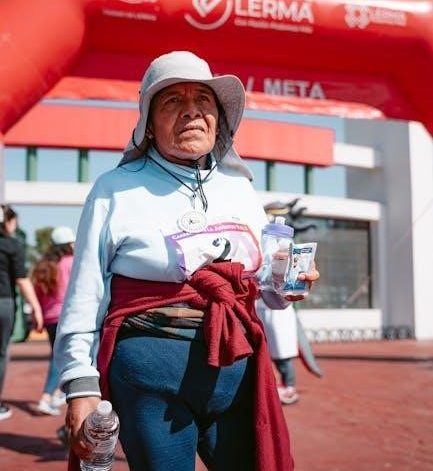Mexican spirit guides are deeply rooted in the country’s rich cultural heritage, offering protection, wisdom, and connection to ancestors and deities, embodying the essence of Mexican folklore and traditions.

1.1 What Are Mexican Spirit Guides?
Mexican spirit guides are protective beings deeply rooted in the country’s folklore and traditions. They are believed to offer wisdom, guidance, and protection to individuals seeking help in their lives. These guides can take many forms, including ancestors, animal spirits, or supernatural entities, each carrying unique symbolic meanings. Often associated with Mexican mythology and the Day of the Dead, they embody the connection between the living and the dead. Spirit guides are thought to assist in navigating life’s challenges, providing strength and clarity. Their presence is honored through rituals, altars, and offerings, reflecting the cultural importance of spirituality in Mexican heritage. By understanding these guides, one can deepen their connection to Mexico’s rich cultural and spiritual landscape.
1.2 The Cultural Significance of Spirit Guides in Mexico
Spirit guides hold profound cultural significance in Mexico, deeply embedded in its rich heritage and traditions. They are revered as protectors, wisdom-keepers, and connectors between the physical and spiritual worlds. These guides are often celebrated during festivals like Día de los Muertos, where altars honor ancestors and spirits. Their presence reflects the country’s blend of indigenous beliefs and Catholicism, creating a unique spiritual identity. Spirit guides also play a vital role in healing practices, such as Curanderismo, and are often invoked in rituals for guidance and protection. Their cultural importance highlights Mexico’s deep respect for ancestry and the supernatural, making them a cornerstone of Mexican spirituality and identity.
1.3 The Connection Between Spirit Guides and Mexican Folklore
Mexican spirit guides are deeply intertwined with the country’s folklore, appearing in stories, myths, and legends that have been passed down through generations. These guides often take the form of iconic figures like La Llorona, El Sombrerón, and Alebrijes, each carrying symbolic meanings tied to cultural values and beliefs. Folklore serves as a vessel to explain their origins, roles, and significance, often blending indigenous and Catholic traditions. Through these narratives, spirit guides are portrayed as protectors, messengers, and wisdom-bearers, reflecting the Mexican people’s deep connection to the spiritual and natural worlds. Their presence in folklore highlights their enduring influence on daily life, rituals, and artistic expressions, making them a vital part of Mexico’s cultural identity.

The Role of Spirit Guides in Mexican Tradition
Spirit guides play a vital role in Mexican tradition, serving as protectors, wisdom-bearers, and connectors to the divine, influencing rituals, ceremonies, and daily life through ancestral and mystical ties.
2.1 Ancestors as Spirit Guides
In Mexican tradition, ancestors are revered as spirit guides, believed to offer protection, wisdom, and guidance. They are seen as a bridge between the living and the divine, providing strength during challenging times. Many families honor their ancestors through rituals, altars, and offerings, seeking their counsel in decision-making and daily life. Ancestors are often called upon during ceremonies to ensure prosperity, health, and family unity. This deep connection reflects the importance of lineage and cultural heritage in Mexican spirituality, emphasizing respect for those who have passed while maintaining their active presence in the lives of their descendants. Their wisdom is cherished, and their influence remains a vital part of cultural identity.
2.2 Animal Spirits in Mexican Culture
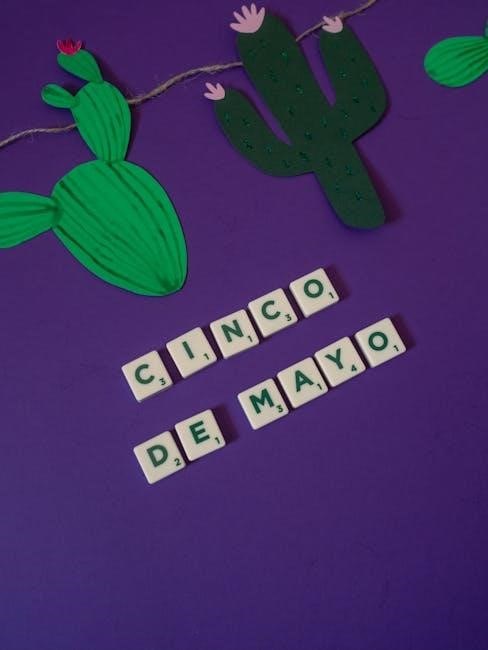
Animal spirits hold a significant place in Mexican culture, often serving as guides and symbols of strength, wisdom, and transformation. These spirits are deeply rooted in indigenous traditions and are believed to carry powerful messages and teachings. Animals like the jaguar, eagle, and owl are particularly revered for their symbolic meanings. Jaguars are associated with protection and inner strength, while eagles represent clarity and vision. Owls, meanwhile, are linked to intuition and wisdom. Many believe these animal spirits can offer guidance during challenging times, helping individuals navigate life’s complexities. Through rituals and meditation, people seek to connect with these spirits, embracing their wisdom and the deep connection they provide to nature and the universe. This tradition highlights the profound respect Mexicans have for the natural world and its inhabitants.
2.3 Deities and Their Role as Spirit Guides
Mexican culture reveres deities as powerful spirit guides, drawing from Aztec and Mayan traditions. These deities embody natural forces and human experiences, offering wisdom and guidance. Figures like Coatlicue, the mother goddess, and Quetzalcoatl, the feathered serpent, symbolize creation and wisdom. Huitzilopochtli, the sun god, represents strength and leadership. These deities are believed to influence daily life, providing protection and insight. Through rituals, prayers, and offerings, people seek their favor and guidance. Their roles extend beyond mythology, becoming integral to spiritual practices and decision-making. By honoring these deities, individuals connect with ancestral wisdom, reinforcing cultural identity and spiritual balance. This deep connection highlights the enduring influence of Mexico’s rich pantheon of gods and goddesses.
Common Mexican Spirit Guides
Mexican spirit guides include iconic figures like La Llorona, El Sombrerón, and Alebrijes, each embodying unique cultural and symbolic meanings, guiding individuals through life’s challenges and spiritual journeys.
3.1 La Llorona: The Weeping Woman
La Llorona, the Weeping Woman, is a haunting figure in Mexican folklore, often depicted as a ghostly woman in white, weeping and searching for her drowned children. Her tragic story, rooted in sorrow and loss, has captivated generations, making her a powerful spirit guide. Believed to haunt rivers and lakes, La Llorona is seen as a protector of the innocent and a symbol of maternal love. Many turn to her for guidance, seeking comfort in her resilience and strength. Her presence is both eerie and comforting, embodying the duality of life and death. As a spirit guide, La Llorona offers solace to those navigating grief and loss, reminding them of the enduring power of love and forgiveness. Her story continues to resonate deeply in Mexican culture, solidifying her role as a revered and enigmatic figure.
3.2 El Sombrerón: The Mischievous Spirit
El Sombrerón is a small, mischievous spirit in Mexican folklore, known for wearing a large hat and causing trouble, particularly with women and their hair. His presence is often felt in forests and mountains, where he is believed to reside. This spirit guide is feared by some but also seen as a protector of the land. El Sombrerón’s tricks are legendary, yet his connection to nature and tradition makes him a significant figure in Mexican culture. His small stature contrasts with his large hat, adding to his enigmatic charm; As a spirit guide, El Sombrerón represents both mischief and wisdom, offering unexpected lessons to those who encounter him. His legacy endures, captivating hearts and imaginations across generations.
3.3 Alebrijes: The Symbolic Spirit Guides
Alebrijes are vibrant, handcrafted wooden figures that have come to represent the beauty, mystery, and magic of Mexico. Originating from Oaxaca, they are created through intricate woodworking and painting, often depicting mythical creatures. Alebrijes are believed to serve as symbolic spirit guides, connecting individuals to their ancestors and the spiritual realm. Their colorful designs and intricate details are thought to carry deep meanings, offering guidance and protection. These figures are deeply tied to Mexican folklore and are often featured in Day of the Dead celebrations. Alebrijes have also inspired modern art and spirituality, becoming a cherished symbol of Mexican heritage and creativity, bridging the past and present.
3.4 Los Duendes: The Guardians of the Forest

Los Duendes are small, mischievous spirits deeply connected to Mexico’s natural landscapes, particularly forests. These guardians are often depicted as short, bearded men dressed in green or brown. Believed to protect the environment, they are known to communicate with trees and animals, embodying the spirit of nature. Their role as spirit guides involves safeguarding the balance of ecosystems and offering wisdom to those who respect the land. While they can play tricks on travelers, they are also seen as benevolent beings who teach humans to live harmoniously with nature. Los Duendes are honored in Mexican folklore through offerings and rituals, reflecting the deep spiritual connection between people and the natural world. Their presence reminds us of the importance of preserving our environment.
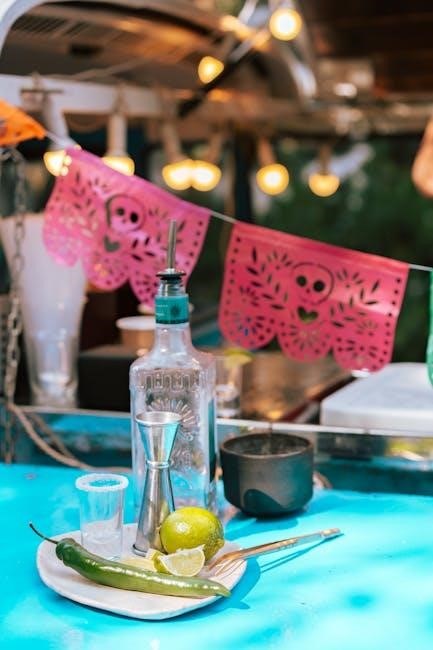
How to Connect with Mexican Spirit Guides
Connecting with Mexican spirit guides involves creating altars, offering traditional items like flowers and candles, and practicing meditation or prayer to establish a meaningful spiritual link.
4.1 Rituals and Ceremonies for Invoking Spirit Guides
Rituals and ceremonies are essential for invoking Mexican spirit guides, fostering a deep spiritual connection. These practices often involve cleansing with herbs like copal or sage, chants, and sacred symbols.
Key elements include setting a sacred space, using traditional instruments like drums or rattles, and reciting prayers to honor ancestors and deities. Offerings such as flowers, candles, and food are placed on altars to attract positive energies.
Meditation and focused intention are crucial, allowing individuals to seek guidance, healing, or protection. Many ceremonies coincide with significant dates, like Día de los Muertos, highlighting the cultural and spiritual significance of these rituals.
These practices not only bridge the physical and spiritual worlds but also strengthen one’s bond with their guides.
4.2 The Use of Altars and Offerings
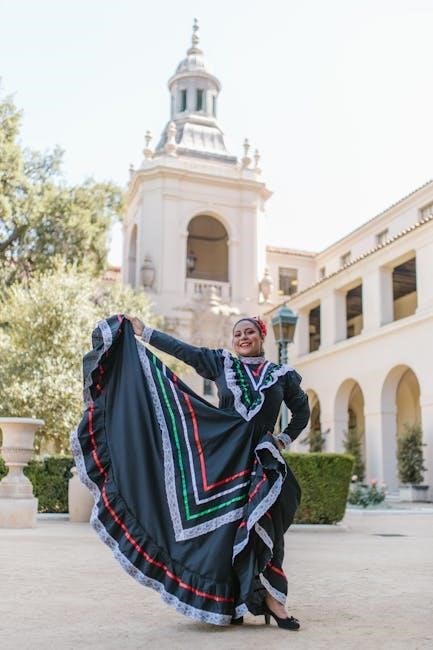
Altars and offerings play a vital role in connecting with Mexican spirit guides, serving as a bridge between the physical and spiritual worlds. Traditionally, altars are adorned with items like flowers, candles, photographs of ancestors, and symbolic objects.
Offerings such as food, drink, and incense are placed to honor and attract spirit guides, showing respect and gratitude. These offerings often include marigolds, a flower believed to guide spirits, and copal, an incense used for purification.
The arrangement of altars reflects the cultural and personal significance of the spirit guides, creating a sacred space for communication and reflection. This practice strengthens the bond between individuals and their spiritual companions, fostering a deeper understanding and connection.
4.3 Meditation and Prayer Practices
Meditation and prayer are essential practices for connecting with Mexican spirit guides, fostering a deeper spiritual connection. These practices often involve focused breathwork, chants, and mantras to create a tranquil state of mind.
Prayers are typically directed toward specific spirit guides, seeking guidance, healing, or protection. Meditation allows individuals to quiet the mind and open themselves to spiritual communication, fostering a sense of unity with their guides.
These rituals are often performed in natural settings or at home altars, emphasizing the importance of intention and reverence. By combining meditation with prayer, individuals can strengthen their bond with spirit guides, gaining insight and spiritual growth. This practice is deeply rooted in Mexico’s spiritual traditions, offering a pathway to inner peace and enlightenment.
The Role of Spirit Guides in Healing
Mexican spirit guides play a vital role in traditional healing practices, offering guidance and energy to restore balance and well-being through rituals, herbs, and spiritual cleansing.
5.1 Curanderismo: Traditional Mexican Healing
Curanderismo is a centuries-old healing tradition in Mexico, deeply intertwined with spirit guides. Practitioners, known as curanderos, use rituals, herbs, and prayers to restore physical and spiritual balance. They believe that spirit guides provide wisdom and energy to diagnose and treat ailments, often linking illnesses to spiritual imbalances. This holistic approach combines indigenous, African, and European influences, reflecting Mexico’s diverse cultural heritage. By invoking spirit guides, curanderos facilitate healing through ceremonies like limpias (spiritual cleansings) and herbal remedies. This traditional practice remains a vital part of Mexican culture, offering a unique blend of faith, nature, and ancient wisdom to address both body and soul.
5.2 The Use of Herbs and Natural Remedies
Herbs and natural remedies play a vital role in traditional Mexican healing practices, often used in conjunction with spirit guides. Plants like sage, chamomile, and copal are believed to possess spiritual properties, aiding in purification and balance. These remedies are frequently used in rituals to cleanse negative energy and restore harmony. Many herbs are prepared as infusions, poultices, or burned in ceremonies to invoke protective spirits. The use of natural remedies reflects a deep connection to the earth and ancestral wisdom, emphasizing holistic well-being. By leveraging these natural elements, practitioners align physical and spiritual health, showcasing the enduring influence of traditional knowledge in modern healing practices.
5.3 Spiritual Cleansing Rituals
Spiritual cleansing rituals are integral to Mexican healing traditions, often conducted with the guidance of spirit guides. These ceremonies aim to remove negative energies, restore balance, and promote well-being. Techniques include the use of sacred herbs like copal and sage, which are burned to purify spaces and individuals. Prayer, meditation, and the invocation of deities or ancestors are also central, creating a sacred environment for healing. Rituals may involve the placement of eggs, candles, or other symbolic items to absorb and eliminate negative forces. These practices, deeply rooted in indigenous and folk traditions, highlight the interconnectedness of spiritual and physical health, offering a holistic approach to healing and renewal.
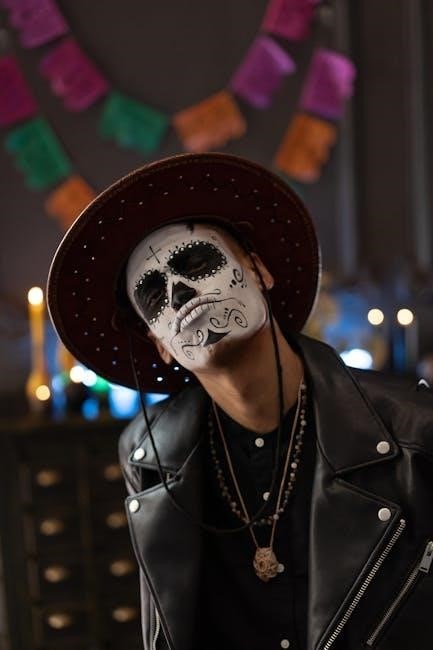
Modern Interpretations of Mexican Spirit Guides
Mexican spirit guides are increasingly embraced in modern culture, blending traditional beliefs with contemporary art, literature, and spirituality, inspiring new forms of creative and spiritual expression globally.
6.1 Spirit Guides in Contemporary Mexican Art
Contemporary Mexican art often incorporates spirit guides, blending traditional folklore with modern techniques. Alebrijes, for instance, have evolved into vibrant, symbolic sculptures that embody cultural identity and spirituality. These art pieces frequently depict spiritual beings like La Llorona or Los Duendes, reflecting the enduring connection to ancestral beliefs. Many artists use these guides as metaphors for personal and collective journeys, combining indigenous symbolism with urban influences. Digital art and installations have also embraced these themes, creating immersive experiences that honor heritage while exploring contemporary issues. This fusion of the mystical and the modern highlights how Mexican spirit guides continue to inspire artistic expression, bridging the past and present in innovative ways.
6.2 The Influence of Spirit Guides on Literature
Mexican spirit guides have profoundly influenced literature, inspiring themes of identity, mysticism, and cultural roots. Authors often draw from folklore, weaving tales of ancestors, deities, and mythical beings like La Llorona and Alebrijes. These narratives explore spiritual connections and the supernatural, reflecting the rich cultural tapestry. Magical realism, a genre popularized by Latin American writers, frequently incorporates spirit guides to symbolize deeper truths and emotions. Literature also serves as a bridge, preserving traditions while introducing them to new audiences. Through stories, spirit guides continue to captivate readers, offering insights into Mexico’s spiritual heritage and its enduring relevance in modern storytelling.
6.3 Spirit Guides in Modern Spiritual Practices
Mexican spirit guides have become integral to modern spiritual practices, blending traditional beliefs with contemporary spirituality. Many individuals now incorporate rituals, meditation, and altar-building into their daily routines to connect with these guides. The use of digital tools and apps has made it easier for people to learn about and engage with spirit guides, fostering a deeper sense of personal growth and holistic wellness. Modern practitioners often seek guidance from spirits like La Llorona or Alebrijes for emotional healing, life direction, and spiritual balance. This fusion of ancient traditions with modern lifestyles highlights the enduring relevance of Mexican spirit guides in today’s world, offering a bridge between cultural heritage and personal transformation.
The Significance of Day of the Dead
Day of the Dead is a vibrant celebration honoring deceased loved ones, bridging the living and spiritual realms, and showcasing the deep connection to Mexican spirit guides.
7.1 The Connection Between Day of the Dead and Spirit Guides
The Day of the Dead (Día de los Muertos) is a sacred celebration where Mexicans honor their deceased loved ones, creating a bridge between the living and the spiritual world. This tradition deeply connects with the belief in spirit guides, as it is believed that the souls of ancestors and loved ones return to earth to guide and protect their families. Altars are built with offerings such as flowers, food, and photographs to welcome these spirits. Rituals like cleaning and decorating gravesites, and burning incense, are performed to communicate with spirit guides. The celebration emphasizes the importance of remembering the dead and seeking their wisdom, reinforcing the cultural belief that spirit guides play a vital role in the lives of the living.
7.2 Rituals Honoring Ancestors and Spirit Guides
Mexicans honor ancestors and spirit guides through vibrant rituals during the Day of the Dead. Altars, or ofrendas, are meticulously constructed with marigold flowers, candles, photographs, and favorite items of the deceased. These offerings are believed to guide spirits back to their families. Incense, like copal, is burned to purify and welcome the ancestors. Traditional foods, such as pan de muerto and mole, are prepared to nourish the spirits. Gravesites are cleaned and decorated with flowers and candles, symbolizing respect and connection. Music and parades add a celebratory tone, blending grief with joy. These rituals create a bridge between the living and the dead, ensuring ancestors continue to guide and protect their loved ones.
7.3 The Symbolism of Altars and Offerings
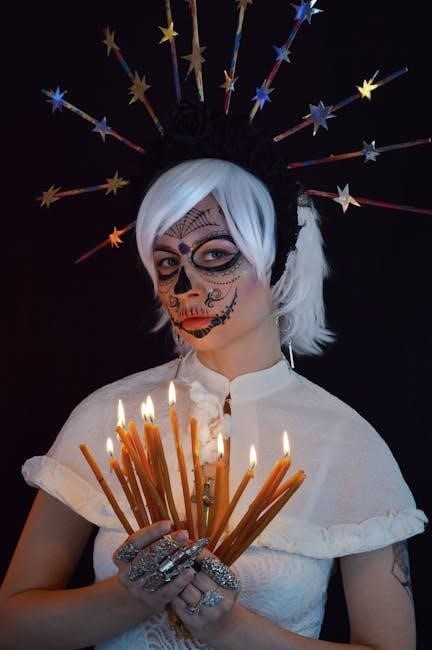
The altars and offerings in Mexican traditions are rich in symbolism, serving as a bridge between the living and the dead. Marigold flowers, known as flor de muerto, are believed to guide spirits with their vibrant color and scent. Candles represent light to illuminate the path, while photographs of loved ones personalize the space. Traditional foods, drinks, and personal items are placed to nourish and honor the ancestors. Incense, like copal, is burned to purify and attract spirits. The arrangement of these elements is deliberate, creating a sacred space that reflects love, remembrance, and connection. These offerings embody the deep respect Mexicans hold for their ancestors, ensuring their presence and guidance in the lives of the living.
Mexican spirit guides embody a profound connection to heritage, bridging past and present, inspiring future generations with their enduring legacy and cultural significance.
8.1 The Enduring Legacy of Mexican Spirit Guides
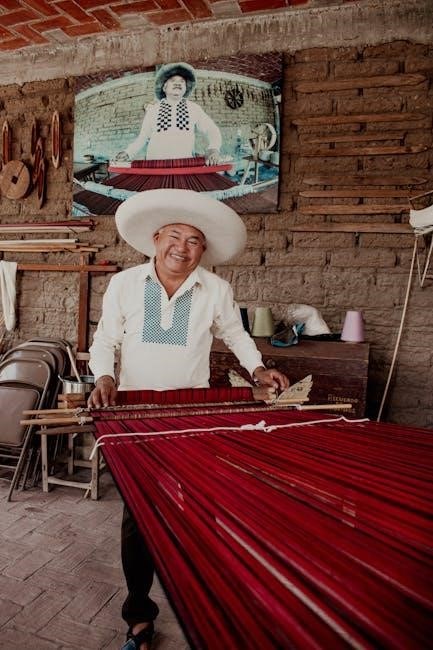
Mexican spirit guides have left an indelible mark on the nation’s cultural identity, blending indigenous traditions with colonial influences. Their enduring legacy is evident in festivals, rituals, and art, where they symbolize wisdom, protection, and connection to ancestors. From the vibrant alebrijes to the revered figures of Day of the Dead, these guides continue to inspire spiritual and creative practices. Their stories, passed down through generations, highlight the resilience of Mexican folklore, ensuring their relevance in modern times. By honoring these spirit guides, people maintain a link to their heritage, fostering a sense of belonging and continuity. Their timeless appeal underscores the importance of preserving cultural traditions for future generations.
8.2 The Importance of Preserving Cultural Traditions
Preserving cultural traditions is essential for maintaining the identity and continuity of Mexican heritage, particularly in the context of spirit guides. These practices, deeply intertwined with history and spirituality, serve as a bridge between generations, ensuring that the wisdom of ancestors is not lost. By safeguarding rituals, stories, and symbols, communities honor their roots while fostering a sense of belonging. Cultural preservation also promotes understanding and respect for the diverse influences that shape Mexican identity. As global influences grow, protecting these traditions becomes vital to preserving the unique spiritual and artistic expressions that define Mexico. Future generations rely on these preserved customs to connect with their heritage and find inspiration in the timeless wisdom of their ancestors.
8.3 How Spirit Guides Continue to Inspire Modern Generations
Mexican spirit guides remain a vibrant source of inspiration for modern generations, blending traditional wisdom with contemporary practices. Their timeless lessons of resilience, connection to nature, and spiritual balance resonate deeply in today’s fast-paced world. Through art, literature, and spiritual practices, these guides influence creativity and provide guidance. Young people, especially, find solace in the cultural identity and ancestral wisdom they offer. The integration of spirit guides into modern life ensures their relevance, fostering a sense of continuity and roots. As a result, their legacy endures, enriching lives and inspiring new interpretations that honor the past while embracing the future.

